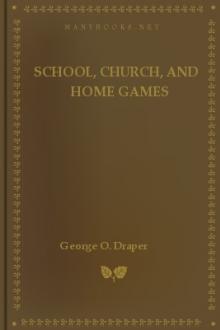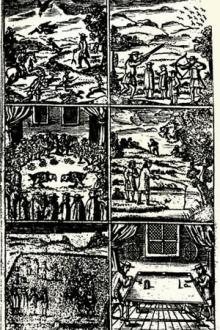School, Church, and Home Games, George Orrin Draper [best classic literature .TXT] 📗

- Author: George Orrin Draper
- Performer: -
Book online «School, Church, and Home Games, George Orrin Draper [best classic literature .TXT] 📗». Author George Orrin Draper
A good book on trees or flowers, a small ax, or any useful article may be the hidden treasure.
Hide and Seek
One boy is chosen to be "IT." He blinds his eyes while the others hide. He counts 100 by 5's, then says, "Ready or not, you must be caught." He then endeavors to find the hidden players. Succeeding he must tag the goal and call the name of the player observed. Should he, in seeking a player, pass the spot where one is hidden, that player can race in to the goal and say, "In free." The one who is "It," however, can tag that player or the goal. When all the players have been discovered, the one first discovered or caught by "It" must blind his eyes for the next game. One who succeeds in getting "In free" is not subject to being "It" in the next hide.
Look Out for the Bear
All of the players hide their eyes, except one, who is the Bear. He hides. When sufficient time has been given for him to find a hiding place, the others seek him. When a player finds the bear he calls out, "Look out for the bear." Thereupon all of the players race back to the home base. The bear endeavors to tag as many of the players before they can reach the home base, as he can. All of the players tagged become bears and hide in the next round of the game, which is the same as the first. All of the bears try to tag as many as possible before they return to the home base. The game continues until the last seeker is caught. He has the privilege of being the bear for the next game.
Still-a-Feet
This is a simple tag game. The player selected to be "It" starts the game by saying, "One, two, three, Still-a-feet, One, two, three, Still-a-feet, One, two, three, Still-a-feet, One, two, three; no more moving of the feet, feet, feet." While "It" is saying this, the players can endeavor to get as far away from him as they desire, but when he has completed the statement, they cannot move their feet. Should he see one of the players moving his feet, he may chase that player until captured. Thereupon, that player helps him chase any of the others. A player cannot be tagged until one of the "Its" has seen a movement of his feet. The first player caught is "It" for the next game. "It" does not need to chase the first player whose feet he sees moving unless he so desires. He may chase any one of the players whose feet he has seen move.
Hang Tag
This is a good game to play around a barn or in a grove where there are low limbs. A player is selected to be "It." He may tag any player who is not hanging with feet clear of the ground. The player tagged immediately becomes "It" and may tag back the one who tagged him after that individual has taken five steps.
Fox in Hole
Any number of players may participate in this game. The playing area should not be too large. A four foot circle is marked upon the ground as a base. One player is selected to be the Fox. While the fox is on the base he may stand on two feet, but when he leaves the base to catch any of the other players he must hop on one foot. Should a player become tagged, he becomes the fox, and the other players may slap him on the back until he is safe on the base. Should the fox put the other foot down, he must return to the base, and every player may slap him on the back until he succeeds in doing this, but no player can block his path to the base.
Fence Tag
This is a simple active game which can be played where there is a low fence or bar, over which the players may easily climb or vault. A player is selected to be "It". He takes his place on the opposite side of the fence from the other players and must climb or vault over and endeavor to tag someone who fails to get over the fence in time. "It" cannot tag anyone whose feet are off the ground, in an effort to get over the fence. Neither can he tag anyone who is standing on the other side of the fence from him. This is a very active game, as it keeps the players leaping back and forth over the fence in an effort to avoid being tagged. A player tagged immediately becomes "It". He cannot tag back the one who tagged him, until after that one has a fair chance to get on the other side of the fence.
Body Guard
A small space is marked off at one end of the ground as a base or goal. One player is chosen to be the chief, an important personage requiring two body guards. The game starts with these three players in the goal and the balance of the players at large. The three come forth, and the two players who act as body guards clasp each other by the hand, and preceding the chief as a shield, endeavor to prevent the other players at large from tagging the chief. The chief himself may avoid being tagged by moving around the guards. Whenever a guard succeeds in tagging a player, the chief and his guards return home, whereupon the player tagged changes places with the man who tagged him. Any player succeeding in tagging the chief becomes the chief.
Sardines
One of the players in the group hides, while the other players seek to find him. Should a player succeed, he endeavors to get into the hiding place unobserved by the others and hides with the first player. As the game continues, and other players succeed in finding the hiding place, the number of hiding players continues to increase until they are packed in like sardines, hence the name. It is difficult for them, crowded together, in this way, to keep from disclosing the hiding place to the remaining players. The game continues until the last player has discovered the hiding place. The first one to make the discovery hides in the next round.
This is a good game to be played around a farm house where there are a number of hiding places, or in the woods where there are trees, boulders and ravines.
Shinny
This is a good game for boys and girls. It has furnished amusement for many generations of children. Each player must secure a stick about 2-1/2 feet long. An alder stick with a small bend at one end furnishes an ideal implement for this game. An old baseball or where this is not procurable, a tin can or a block of wood, may be used. The players are divided into two teams. Two stones, placed about five feet apart at each end of the playing space, serve as goals. The playing space should be about 30 to 50 yards in length. A level stretch of road can be used, or an open field. The game starts by each team taking a position anywhere in the half of the field nearest the goal they are defending.
The ball is placed in the centre of the playing space. Two opposing players, known as centres, take a position on opposite sides of the ball, within a distance of two feet of it, with the end of their clubs on the ground. The process of putting the ball into play is called "facing off". In facing off, the two centres raise their clubs from the ground and hit them together above the ball. They do this three times and after hitting them above the ball for the third time, they are allowed to hit at the ball, endeavoring to knock it towards their own players or towards the opponent's goal. The game is now on and each player endeavors to knock the ball, by means of his club, towards and through the opponent's goal. Swinging the club higher than the shoulder is barred. Should the ball be knocked outside of the playing space, it is brought back in and faced off by any two opposing players at a point well within the playing space, opposite to where it went out of bounds.
A goal counts one point and after each goal the ball is faced off in the centre. Goals should be changed in the middle of the game, so that no team may have an advantage over the other because of location of goals.
One Step Off and All the Way Across
Two goal lines about fifteen yards apart are marked upon the playing space. This game can be played on the road, using the opposite curb stones as goal lines. A player is selected to be "It" and takes his place between the goal lines. He starts the game by saying, "One step off and all the way across". Thereupon, all the players who may be behind either goal line, upon stepping over the goal line, must run across the space between the goal lines towards the opposite goal. "It" endeavors to tag the players as they run between the goal lines. Each player tagged, helps "It" in tagging the others. After the game starts the players may run back and forth between the goal lines at will. The game continues until all the players are tagged. The first player tagged becomes "It" for the next game.
Wheel Away
This game is similar to the preceding game except the players must be behind the same goal line, and the one who is "It" says, "Wheel away", which is the signal for all of the players to run across the space to the other goal. Those tagged by "It" in their effort to do this, help him to tag the other players. All of the players are expected to run immediately upon hearing "Wheel away". Otherwise "It" may cross the goal line and tag them. The one first "It" is the one to say "Wheel away" each time, until all of the players have been caught. The one first caught is "It" for the next game.
Bombardment
This is a game enjoyed by boys. It is necessary to have half a dozen soft yarn balls or indoor baseballs or bean bags for this game. A large number of players can participate. A playing space is marked off on the ground with a line drawn through the centre. The group is divided into two equal teams. The teams take positions on opposite sides of the center line. The balls are divided equally between the two teams. At the signal to start the balls are thrown at such opponents as may hold one of the balls. The players may move around in their playing space, but are not allowed to step over the centre line. Any player can recover a ball, but so long as he holds the ball in his





Comments (0)